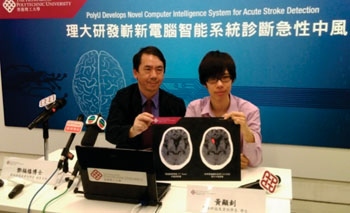Computer Intelligence Detects Acute Strokes
By HospiMedica International staff writers
Posted on 28 May 2015
Computer-aided detection (CAD) technology combines sophisticated calculations, artificial intelligence, and pathology to help medical professionals accurately diagnose stroke.Posted on 28 May 2015
CAD stroke technology, developed by researchers at the Hong Kong Polytechnic University (PolyU; Hong Kong), is a system that analyzes computed tomography (CT) brain scans to identify suspect regions in the brain. When blood flow to the brain is blocked, an area of the brain decreases in density due to insufficient blood flow, pointing to a possible ischemic stroke. The first part of the system is thus an algorithm for automatic extraction of areas of circular adaptive region of interest (CAROI), which reads and analyzes 80–100 X-rays slices.

Image: Dr. Fuk-hay Tang (left) presenting the CAD system (Photo courtesy of Yvonne Lou/Hong Kong Polytechnic University).
The second part the CAD stroke system is an artificial neural network that performs automated reasoning and sophisticated calculations and comparisons to locate areas suspected of insufficient blood flow. It detects where the images look abnormal, highlighting them for doctors’ review; such abnormalities include loss of insular ribbon, loss of sulcus, and signs of a dense middle cerebral artery (MCA). Since the system is able to detect subtle change in density, it is also able to detect hemorrhagic stroke, which is presented as increase in tissue density.
The detection accuracy is 90%, which is as high as that conducted by specialists, but at a much reduced time of just three minutes. False-positive and false-negative cases, and other less serious conditions that mimic a stroke can also be ruled out, allowing a fully-informed decision to be made. The CAD system is also equipped with a built-in artificial intelligence (AI) feature, which helps it to learn by experience. With every scan passing through, along with feedback from stroke specialists, the application improves its accuracy over time.
“Providing treatment to acute stroke patients within the golden hours of stroke treatment, i.e., three hours of stroke onset, is vital to saving lives. However, stroke specialists do not work around the clock, increasing the risk of misdiagnosis and delayed diagnosis of acute stroke,” said Fuk-hay Tang, PhD, of the department of health technology and informatics. “This novel system, which analyses brain scans, could help save lives by assisting non-specialists in diagnosis by providing them a second opinion. Timely diagnosis and treatment within three hours of stroke onset also minimizes damage.”
Related Links:
Hong Kong Polytechnic University














